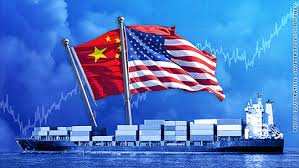China’s factory activity grows as easing trade spat revives demand

Manufacturing activity in China expanded for a second straight month in December as seasonal demand and signs of progress in trade talks with Washington boosted factories’ output and order books.
China’s official Purchasing Managers’ Index (PMI) was unchanged at 50.2 in December from November, the National Bureau of Statistics said on Tuesday, slightly higher than the 50.1 expected in a Reuters poll of analysts.
It also remained above the 50-point mark that separates monthly growth from contraction.
The better-than-expected readings suggested some recovery in the world’s second-largest economy this month. Production rose at the fastest pace in over a year while growth of total new orders was only a notch lower than a recent high hit last month.
While the upbeat indicators show the economy ending 2019 on a firmer footing than initially expected, there are deeper concerns such momentum may not continue next year.
“The extended strength in the official manufacturing PMI certainly looks positive for markets, but we believe this may not be sustainable, and the economy has yet to hit the bottom,” Nomura analysts said in a note after the data
Still, the stability seen recently prompted Nomura to revise up its gross domestic product forecasts for the fourth quarter to 6.0% from 5.8%.
Zhao Qinghe, a senior statistician with the statistics bureau, attributed the PMI resilience to increasing demand and production ahead of the Lunar New Year holiday, which falls in late January.
Production for sectors such as the textile, pharmaceutical and auto and telecom equipment industries stood at relatively high levels. The survey also showed a boost in firms’ willingness to stock up inventories in order to meet production need ahead of the holidays.
IMPROVING DEMAND
The PMI aligns with other recent signs of strength with profits at China’s industrial firms growing at the fastest pace in eight months in November, data showed last week.
Growth in industrial and retail sectors also beat expectations in November as government support propped up demand.
It also co-incides with signs of improvement in Sino-U.S. trade talks, which have boosted global investor confidence and helped Chinese manufacturers book new orders from abroad, even though a final deal is yet to be inked.
New export orders, in particular, rose for the first time since May 2018 in December.
China and the United States have announced a Phase 1 agreement that would reduce some U.S. tariffs in exchange for more Chinese purchases of American farm products, which analysts believe could stimulate China’s exports and corporate investment in the near-term.
On Monday, White House trade adviser Peter Navarro said the Phase 1 deal would likely be signed in the next week and cited a report that Chinese Vice Premier Liu He would visit the United States this week.
“The bottoming-out global economy and the thawing of U.S.-China trade tensions have resulted in an improvement in global demand. China’s exports are expected to have rebounded in December,” said analysts at Southwest Securities.
“The rebounding demand is supporting the economic growth in the next quarter or two.”
There were signs of persistent softness, however, with a sub-index for imports at 49.9, although the pace of contraction slowed.
Similarly, factories also continued to shed jobs in December, although the pace of reduction did not accelerate.
Over 25 million jobs were trimmed from the industrial sector from end-2013 to end-2018, mostly in labour intensive industries, the latest census showed, as labour costs rose.
Growth in China’s services sector activity cooled in December with the official non-manufacturing PMI dropping to 53.5, from an eight-month high of 54.4 in November, a separate NBS survey showed.
The activity in the construction sector pulled back as the winter slowed demand, with the sub-index easing to 56.7 from 59.6 the previous month. But new contracts for civil engineering projects rose on a push for more infrastructure projects to stimulate growth, the NBS said.
Beijing has relied on a strong services sector to offset manufacturing weakness. However, a broader economic slowdown since late last year has limited the sector’s resilience.
China plans to set a lower economic growth target of around 6% in 2020 from this year’s 6-6.5%, relying on increased state infrastructure spending to ward off a sharper slowdown, policy sources told Reuters.


